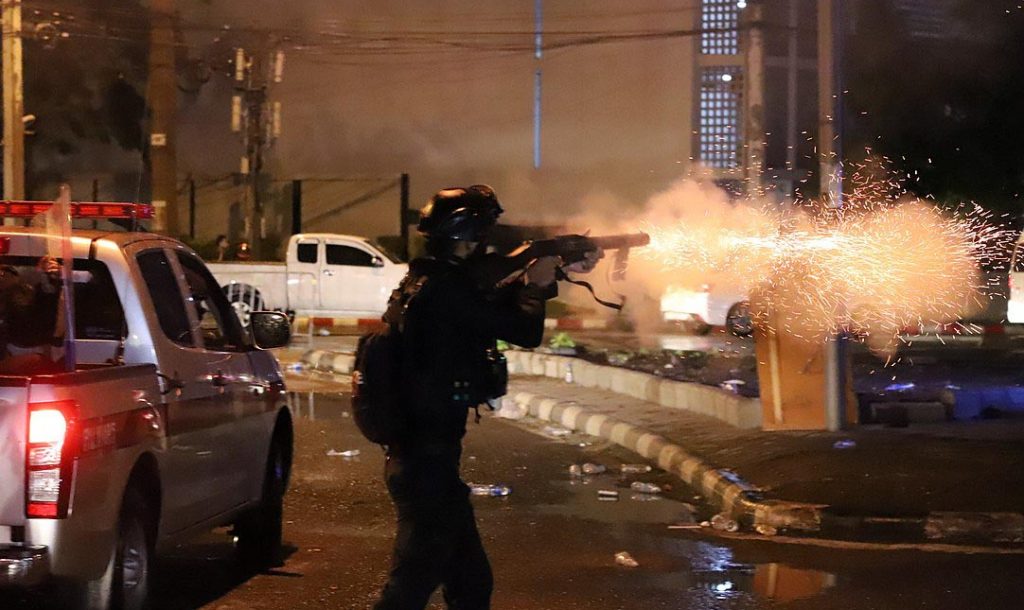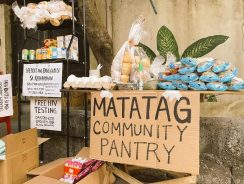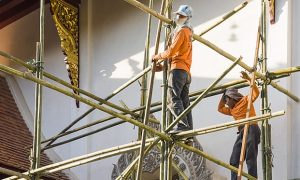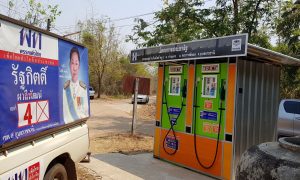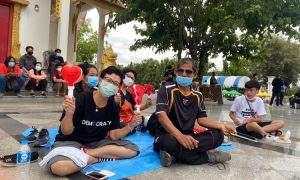Since February 2020, there has been a proliferation of mass youth movements in Thailand. Both university and high school students have come out onto the streets to call for change, not only free and fair elections, but also structural changes in the education system, a more democratic constitution and political system, and above all, reform of the monarchy. Small self-organised student groups have sprung up throughout the country in big cities and small towns. Countless creative symbolic actions, colourful political rallies, and festive political campaigns were peacefully organised by different groups of politically active youngsters.
By early August 2021, as the pandemic situation eased after the April-2021 wave, a new type of mass youth protest emerged, but this time, in a very different atmosphere from previous rounds. These protesters who insisted on standing up against police tear gas and rubber bullets later named themselves “Thalugas” or protestors brave enough to break through the tear gas. The confrontations continued daily for more than 2 months, from dusk until late at night and sometimes even 2-3 o’clock in the morning, despite a COVID curfew. By the end of October, nearly 400 people, including 192 protesters under the age of 18, had been arrested on various charges both at the protest site and their homes.
In order to understand the dynamics of the student movements in Thailand during the past 2 years, this article compares the two major phases of activism in Thailand in terms of socio-economic status, structural problems, aspirations, trigger factors driving participants onto the streets, political and policy demands and proposals, and strategy and tactics. This account is based on earlier research on the youth movement in 2020, and in-depth interviews with more than 30 front-line protesters at the Din Daeng intersection this year.
Middle class & lower class youth
All protests since 2020 until the recent ones at Din Daeng have been led by young people frustrated with the Thai state. The movement started in early 2020 but the protests that began in August 2021 comprised protesters with different socio-economic characteristics.
The majority of youngsters in earlier protests came from “middle-” or “upper middle-” class family backgrounds. They were bright students from leading schools and universities in Bangkok and elsewhere. Unlike earlier generations from conservative middle classes, this generation grew up in a world of rapid change, including liberal socialisation through family and colleagues, the expansion of social media and a disruptive economy. This has led them to believe that change is the only means to survive in the future.
By contrast, those joining the Din Daeng protests in 2021 are from “lower middle-” and “lower-” class backgrounds. These deprived youths have to struggle to survive inequality and oppressive state and social structures that include a difficult economy, an ineffective and oppressive education system, family breakdown, state violence, and low-income employment.
Political Party-Freedom & Covid Disruption
Within a socio-economic environment that has fomented frustration among these two youth groups, they were provoked into coming out onto the streets by different immediate triggers, and they made different demands for change.
Before 2020, middle-class youth had already succeeded in political campaigns both online and via the ballot box. In late 2015, just a year after the 2014 military coup, a broad-based youth-led online protest successfully blocked a government proposal for a “single gateway” in an effort to suppress online freedom. More than 166,554 people signed an online petition “Oppose Thai government’s use of a Single Internet Gateway” on Change.org. More than 100,000 users attacked government websites to express disagreement with this policy. After several rounds of online protests, the Minister announced a retreat. In the 2019 general election, the vote from younger generations managed to push the Future Forward Party to 3rd place. The victory of the FFP showed active younger generations moving from online to the ballot box.
The rise of the youth movement on the streets in early 2020 was provoked by the efforts of the Thai state to destroy the political party they had voted for and to violate their political rights and freedoms. Right after the Constitutional Court ruled to dissolve the FFP and ban its executives from politics for ten years for allegedly accepting financial support from an illegitimate source, Thai youth organised protests in countless schools and universities throughout the country. At the same time, state suppression of political freedoms, as in the enforced disappearance of Wanchalearm Satsaksit, a young political activist who criticised the royal family and later took refuge in Cambodia, led many high school students to stand up to protect their political rights before it was too late.
What drove lower class youths onto the streets was different. They were motivated by the severe economic and health impacts of COVID-19 and the ineffective government policies for mitigating its impact on vulnerable people. As young workers in the informal labour sector, when COVID-19 hit, they were most impacted and least protected. With no state protection from the immediate negative impacts, these youngsters decided to join the protests at Din Daeng. As poor students, the switch to online classes made it more likely that they would drop out of school, partly because of the cost of accessing online devices and the internet, and partly because it was harder to gain useful skills from online lessons. Government figures show that more than 43,060 students, or 14.6 percent of all students in the country, dropped out of school in 2021. There is also a possibility that a further 1.9 million students from economically vulnerable families may have to leave school next year. Living in slums and crowded homes also increased the possibility of getting infected by COVID-19. Low-income families found it nearly impossible to access decent health care, particularly at the peak of each COVID wave. Above all, when the country and cities went into lockdown, young workers in the food, hospitality and entertainment industries were the very first to face reduced working hours, salary cuts and eventual layoffs, and were the last to return to work. Being under 18-years-old, they were the last group to access vaccines, which in turn reduced their opportunities to get back into work.
Structural Reforms vs Immediate Administrative Changes
In broad terms, all youth groups are calling for change, but at different levels. The original youth movement last year mainly focused on changes and reform at the structural level. The demands included education reform, military reform, an end to business monopolies, a more democratic constitution, dissolution of parliament and new free and fair elections, and monarchy reform. These proposals challenge core conservative values and institutions. Their reform manifesto was crafted around a new constitution, restrictions on the power of the monarchy and bureaucratic reform.
In contrast, the Din Daeng protesters call for immediate changes. Their ultimatum for the PM’s resignation was clear. Their lives are on a knife edge; they are now losing jobs, homes and livelihoods. To survive the impact of Covid-19, they demand urgent change. They can’t wait for the whole-scale structural reforms called for by last year’s movement. Their focus is therefore on administrative change. For them, a change of national leadership and cabinet would at least bring in an immediate change in policy.
Peaceful Symbolic Actions vs Confrontation and Attack
The two protests movements differ not only in ideas and demands, but also in the form of political expression and action. The youth movement that began last year was based upon and persisted in adhering to nonviolence with creative and playful symbolic activities. Their leadership had long experience in earlier democratic movements even before the 2014 coup, when they learnt the lessons of how powerful, low-cost and high-impact peaceful strategies work. Insisting on nonviolence not only legitimises the powerless, like younger generations, but also delegitimises an oppressive state that resorts to violence. At the same time, with experience and skills in online political campaigning, middle-class youth were very keen on developing creative on-site symbolic campaigns in parallel with online actions.
Protests and Pandemics: Civil Society Mobilisation in Thailand and the Philippines
...creating spaces for civil society should be integral to post-pandemic recovery and reconstruction plans.
By contrast, the youth at Din Daeng marched into face-to-face confrontation with security authorities. The majority were first-time protesters with very little experience or knowledge of political movements. Thereafter, their choice of action was very limited. Suddenly finding themselves in a leaderless movement, each individual resorted to the pattern of action they were familiar with in dealing with—state authorities—“confrontation-attack”. Aware that the earlier peaceful and symbolic campaigns had hardly succeeded in promoting change on the part of the authorities, they opted for something different to draw public attention and put pressure on the authorities. The protesters equipped themselves with catapults, small explosive devices like firecrackers or ping-pong bombs, firebombs, and bullet-proof shields. They burned tyres and set fire to symbols of state authority like police booths, CCTV cameras and police vehicles. In response, riot police ramped up their anti-protest measures. In addition to water cannon, tear gas and rubber bullets (often deployed in ways that contravened international guidelines), the police carried out serious physical attacks, snatch arrests and home raids.
On-line vs Off-line Campaigns
In term of mobilisation, the 2020 youth movement was an outstanding example of a successful and vibrant online social movement. Various social media platforms mobilised resources, organized protests, recruited members and participated in political campaigns. Twitter, Telegram and Clubhouse were among the most effective in spreading information, mobilising people to join flash mobs, coordinating leaderless protests, setting up new campaigns.
In contrast, the Din Daeng protests are a formidable specimen of an “off-line” movement. Participants and resources are mobilized through word of mouth among pre-existing social networks like slum neighbourhoods, technical school classes, food delivery rider groups, etc. As the protests occur daily at the same location with same type of participation, there was little need for organisation. Individuals with a small group of friends with catapults and small explosive devices can set up actions, with social media playing a minor role. Facebook and TikTok provide political inspiration and entertainment rather than serve as tools either to monitor the situation or express political ideas.
Cross-Class Generation of Active Citizens
In spite of differences in socio-economic status, political demands and protest strategies, the two groups have several features in common. They are politically active citizens and stand in support of political freedom and social justice. The middle-class youth made very elaborate demands for freedom of political expression, socio-economic equality, respect for diversity, and above all, free and fair elections and a more democratic constitution. Similarly, the lower-class youth at Din Daeng are well aware of political freedoms and rights and the power of ordinary people in pushing for political change. In interviews, the very first response was “freedom of political expression is legal”. They were also able to relate the problems they have encountered with the mismanagement of the government. Above all, they believe in the power of individuals to create change.
 Facebook
Facebook  Twitter
Twitter  Soundcloud
Soundcloud  Youtube
Youtube  Rss
Rss 